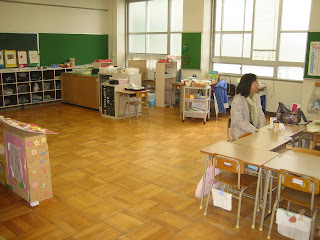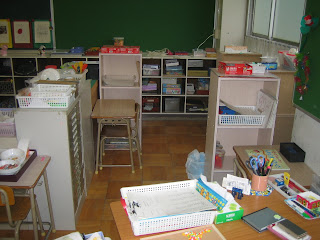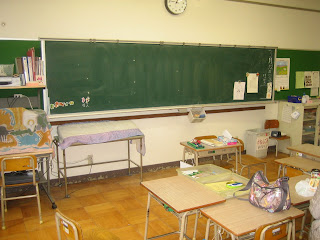Before arriving in Japan, Joe and I had to visit a Boeing psychologist to make sure we were ready for the overseas commitment. During the session, the therapist asked me what I did for a living - when I told her I was a Special Education Teacher, she basically said, "don't expect to find a job like that over in Japan." I was under the impression that people with disabilities were essentially hidden in Japan. I was even told by our relocation agency that families send their children with disabilities to institutions. So in the two months that we have been here, I have been constantly on the look out for people with disabilities. Very rarely do I see anyone with a disability - except for an occasional high-functioning person with mental retardation on the subway or a blind person walking around. In a city of about 2.2 million people, I find it surprising that I don't see more people with disabilities around! So this essentially confirmed what I had been told - people with disabilities are not talked about nor accepted in Japanese society.
This week, however, has changed my opinion! My Japanese teacher asked to see photos of my family and friends. Of course I showed her many photos of my students and classroom in Seattle. She was amazed that I did that kind of work and instantly researched how I could have the opportunity to see what children with disabilities are like in Japan. Within a few days, she located an old friend who is a special education teacher in Japan, and asked her if we could come and visit her classroom! So on Monday, my Japanese teacher and I spent the entire day observing and interacting with 15 amazing students with special needs! :) As it turns out, the psychologist in Seattle and relocation person here in Japan don't know what they're talking about! These 15 students with special needs are placed in a regular school along side their regular peers. Like my classroom in Seattle, the students spend their academic time in the special ed classroom learning basic skills - and then have the opportunity to learn and socialize with their regular education peers during art, P.E., music, recess, etc. The students ranged in their disabilities, from Autism to Down syndrome and mental retardation.
It was such a great experience... to see that despite the different language and culture, the school and children are the same. They are learning the same skills, treated the same as other students, in a fun and supportive learning environment. It felt like home!
Something funny that my staff in Seattle reading this will think great: My students' in Seattle love to play the game musical chairs. We used to always play this game for all of our parties and for special occasions. The students in this classroom have the same passion for the game! Funny how this game is popular around the world. We played it about 5 times today, and it never got old. :)
I should also note that this is an elementary school. The 15 students in special education range from 7 - 12 years old. They are divided into 3 different classrooms. Here are some pictures of one of the classrooms.....

The school year ends in March here. So the room looks very plain right now, as all the art projects and decorations have been taken down. But this picture shows that the room is set up very similar to special education rooms in the U.S. The desks are set up in front of the chalkboard for "meeting and group time," there is a play area in the left hand side, and in the back corner of the room is the "work area" with individual desks for students and their work-boxes.

The students' work area. They are all at different levels, so each student is working on different things. For math: from identifying numbers, to counting money, to multiplication. For reading: from identifying letters (or Japanese characters), to reading words, to reading stories. Etc. Like my students in Seattle, the students in this room are also working on life skills, such as: appropriate social skills, daily chores, manners and eating skills.

Front of the room - the cluster of desks for group time.

The teacher and students built this "sweet house." Literally, it is decorated with pictures of candy and other goodies! The children use this house to play in during free time, or to be alone to calm down when having stress or anxiety.

I know how progressive Japan is in so many areas, but especially impressed with what you shared about special education there!
ReplyDeletevery cool - so glad you were able to have this experience!!!
ReplyDelete